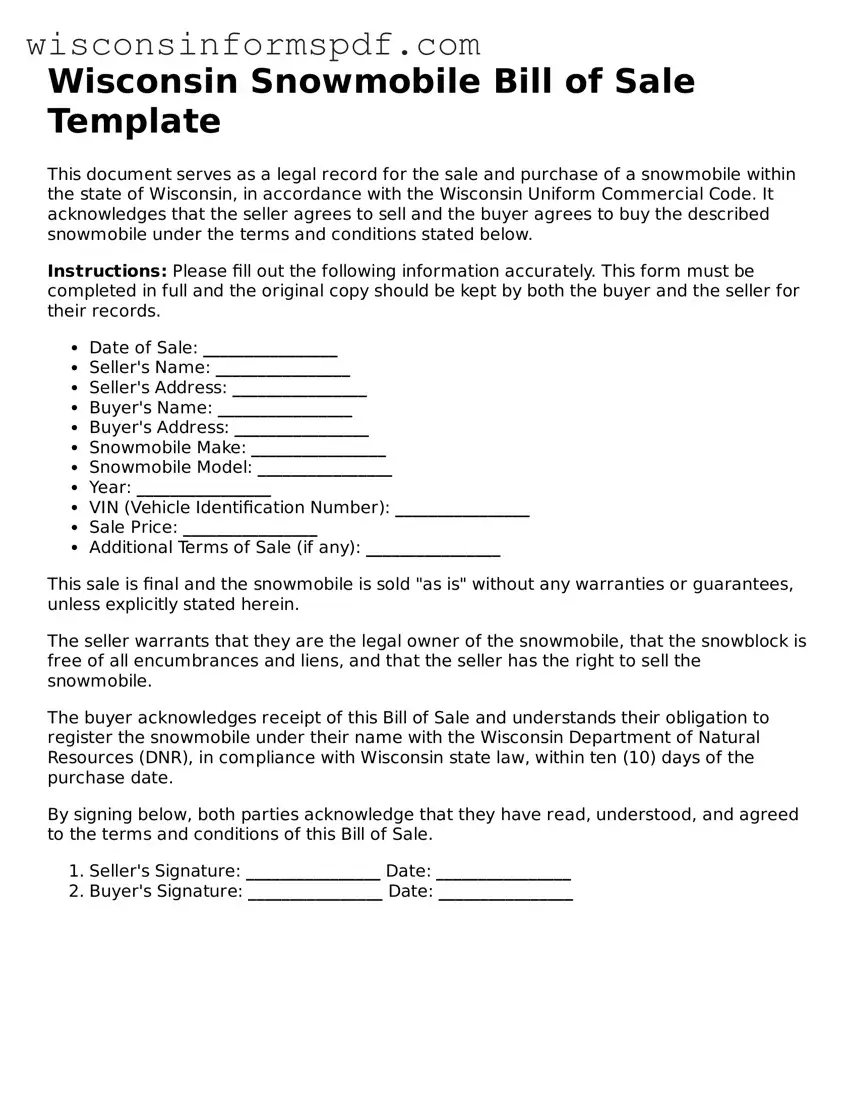The Wisconsin Snowmobile Bill of Sale form shares similarities with the Vehicle Bill of Sale form in many aspects. Both documents serve as proof of purchase and transfer of ownership, detailing information about the buyer, seller, and the item being sold. They accurately describe the item being transferred, including make, model, year, and identification numbers, ensuring a clear record of transfer for legal and registration purposes.
Comparable to the Boat Bill of Sale, the Wisconsin Snowmobile Bill of Sale form also requires specific information about the item sold, including identifying marks and registration numbers. Both forms are necessary for the new owner to legally register the item in their name with the state authorities, and they often require notarization to verify the signatures of the parties involved.
Similar to the Motorcycle Bill of Sale, this document is crucial for the legal transfer of ownership. It serves both as a receipt for the transaction and as a document outlining the condition of the snowmobile at the time of sale. This includes any warranties or "as-is" status, mirroring the practice in motorcycle sales where such conditions significantly affect the agreement between parties.
Like the Firearm Bill of Sale, the Wisconsin Snowmobile Bill of Sale incorporates safety measures by recording the transaction in detail. Both forms may be used in court or with authorities as evidence of ownership transfer, emphasizing the responsible sale and purchase of potentially dangerous property. They also serve to protect seller liability once the item is legally transferred to the new owner.
Analogous to the General Bill of Sale, this form serves a similar basic function: to document the sale and purchase of personal property. While the General Bill of Sale can apply to a wide variety of items, the Snowmobile Bill of Sale is specifically tailored for the transaction involving a snowmobile, addressing specific legal requirements and registration processes related to this type of property.
The Wisconsin Snowmobile Bill of Sale form and the Aircraft Bill of Sale share the characteristic of dealing with specialized forms of transport. Both necessitate detailed descriptions of the item being sold and may require additional documentation for registration with the respective federal or state agencies, underscoring the importance of accuracy in the sale process.
Equating to the Equine Bill of Sale, both forms ensure the buyer is aware of the specific condition and history of the item (or animal) being purchased. They provide a framework for disclosing specifics such as health, in the case of an equine sale, or mechanical condition and previous use in the case of a snowmobile, highlighting the necessity for transparency in these transactions.
Matching the Pet Bill of Sale, the Wisconsin Snowmobile Bill of Sale includes safeguards for the transaction, documenting the exchange to protect both parties legally. While the specifics of the item being sold differ greatly, both forms play a crucial role in establishing a clear agreement and terms of sale, including any guarantees or the lack thereof.
Synonymous with the Furniture Bill of Sale, this form confirms the sale and transfer of ownership of a piece of property from one person to another. Both documents detail the condition of the item at the time of sale and include both parties' agreement on price, serving as a legally binding receipt that can be referred back to in disputes or for registration purposes.
Closely related to the Tool Bill of Sale, the document for the snowmobile transaction records the sale of a specific item, including a detailed description and any conditions of sale, such as warranties or "as-is" status. Both forms ensure a clear understanding between the buyer and seller, providing a written record that outlines the details of the transaction for future reference or in case any legal issues arise.
